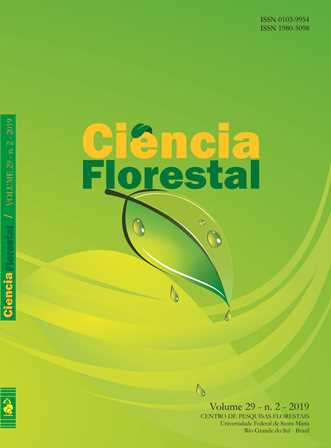Classification of successional stages in atlantic forests: a methodological approach based on a fuzzy expert system
DOI:
https://doi.org/10.5902/1980509830688Keywords:
Ecological succession, Fuzzy logic, Atlantic ForestAbstract
A method based on fuzzy modeling was developed for the classification of the stages of a forest succession. The construction of the model considered the criteria established by CONAMA, which define secondary vegetation in the initial, middle, and advanced stages of regeneration of the Atlantic Forest, as guidelines for the management of native vegetation in the state of São Paulo. The proposed model was applied for classifying cases reported in the literature, where floristic and phytosociological analysis of the forest structure had been performed employing the judgment of experts. The fuzzy modeling approach provided good agreement with the conclusions of the experts, according to the Kappa index. In conclusion, fuzzy modeling is a promising technique for addressing subjectivity and uncertainty in the classification ofsuccessional stages in the Atlantic Forest.
Downloads
References
BARRETTO, E. H.; CATHARINO, E. L. Florestas maduras da Região Metropolitana de São Paulo: diversidade, composição arbórea e variação florística ao longo de um gradiente litoral-interior, estado de São Paulo, Brasil. Hoehnea, São Paulo, v. 42, n. 3, p. 445-469, 2015.
BARRETTO, E. H. P. Florestas climáticas da região metropolitana de São Paulo - SP: caracterização florística estrutural e relações fitogeográficas. 2013. 157 f. Dissertação (Mestrado) - Instituto de Botânica da Secretaria de Estado do Meio Ambiente, São Paulo, 2013.
BRASIL. Conselho Nacional do Meio Ambiente. Resolução CONAMA no 01, de 31 de janeiro de 1994. Regulamenta o art. 6º do Decreto nº 750, de 10 de fev. de 1993 para o Estado de São Paulo. Disponível em: <http://www.mma.gov.br/port/conama/res/res94/res0194.html>. Acesso em: 16 set. 2012.
BRASIL. Lei nº 11.428, de 22 de dezembro de 2006. Dispõe sobre a utilização e proteção da vegetação nativa do Bioma Mata Atlântica, e dá outras providências. Diário Oficial da União, Brasília, DF, 26 dez. 2006.
D`ORAZIO, F. A. E. Composição e estrutura de florestas aluviais do médio vale superior do rio Paraíba do Sul. 2012. 96 f. Dissertação (Mestrado) - Instituto de Botânica da Secretaria de Estado do Meio Ambiente, São Paulo, 2012.
GOMIDE, F. A. C.; GUDWIN, R. R.; TANSCHEIT, R. Conceitos fundamentais da teoria dos conjuntos fuzzy, lógica fuzzy e aplicações. 2014. Access in: <ftp://calhau.dca.fee.unicamp.br/pub/docs/gudwin/publications/ifsa95.pdf>.
LANA, J. M. et al. Análise dos estágios de sucessão de áreas de Mata Atlântica sob a influência de plantações florestais, Vale Do Rio Doce, Minas Gerais, Brasil. Revista Árvore, Viçosa, MG, v. 34, p. 733-743, 2010.
IBGE. Manual técnico da vegetação brasileira. [S.l.]: IBGE, 2014. Disponível em <ftp://geoftp.ibge.gov.br/documentos/recursos_naturais/manuais_tecnicos/manual_tecnico_vegetaca o_brasileira.pdf >. Acesso em: 31 maio 2017.
MAGNANO, L. F. S. et al. Os processos e estágios sucessionais da Mata Atlântica como referência para a restauração florestal. In: MARTINS, S. V. Restauração ecológica de ecossistemas degradados. 1. ed. Viçosa, MG: Editora UFV, 2012. p. 69-100.
MARDEGAN, C. M. Estádio sucessional e estrutura fitossociológica de um fragmento de vegetação floretal existente às margens do Rio Dourado em Guaiçara, SP. 2006. 85 f. Dissertação (Mestrado) – Universidade Estadual Paulista, Botucatu, 2006.
MORAN, E.; BRONDÍZIO, E. Land-Use change after deflorestation in Amazônia. In: LIVERMAN, D. E. People and Pixels: linking remote sensing and social science. Washington: National Academy Press, 1988. p. 94-120.
RAMOS, E. et al. Estudo do componente arbóreo de dois trechos da Floresta Ombrófila Densa Submontana em Ubatuba (SP). Biota Neotropica, Campinas, v. 11, n. 2, p. 313-335, 2011.
ROSÁRIO, R. P. G. Estágios sucessionais e o enquadramento jurídico das florestas montanas secundárias na Reserva Florestal do Morro Grande (Cotia, SP) e entorno. 2010. 153 f. Dissertação (Mestrado) - Instituto de Botânica da Secretaria de Estado do Meio Ambiente, São Paulo, 2010.
SALDARRIAGA, J. et al. Long-Term Chronosequence of Forest Succession. The Upper Rio Negro of Colombia and Venezuela. Journal of Ecology, Oxford, v. 76, p. 938-958, 1988.
SILVA, I. C. Caracterização fisionômica de fragmentos vegetacionais do distrito de Rubião Júnior, município de Botucatu, São Paulo. 2010. 116 f. Dissertação (Mestrado) - Instituto de Biociências, Campus de Botucatu, Botucatu, 2010.
SIMINSKI, A. et al. Sucessão florestal secundária no município de São Pedro de Alcântara, Litoral De Santa Catarina; estrutura e diversidade. Ciência Florestal, Santa Maria, v. 14, p. 21-33, 2004.
SIMINSKI, A.; FANTINI, A. C. Classificação da Mata Atlântica do litoral Catarinense em estádios sucessionais: ajustando a lei ao ecossistema. Floresta e Ambiente, Seropédica, v. 11, n. 2, p. 20-25, 2004.
SIMINSKI, A.; FANTINI, A. C.; REIS, M. S. Classificação da vegetação secundária em estágios de regeneração da Mata Atlântica em Santa Catarina. Ciência Florestal, Santa Maria, v. 23, p. 369-378, jul./set. 2013.
WRIGHT S. J. The future of tropical forests. Annals of the New York Academy of Sciences, New York, v. 1195, p. 1-27, 2010.
ZADEH, L. A. Outline of a new approach to the analysis of complex systems and decision process. IEEE Transactions on Systems, Man, and Cybernetics, New York, v. SMC-3, n. 1, p. 28-44, jan. 1973.







